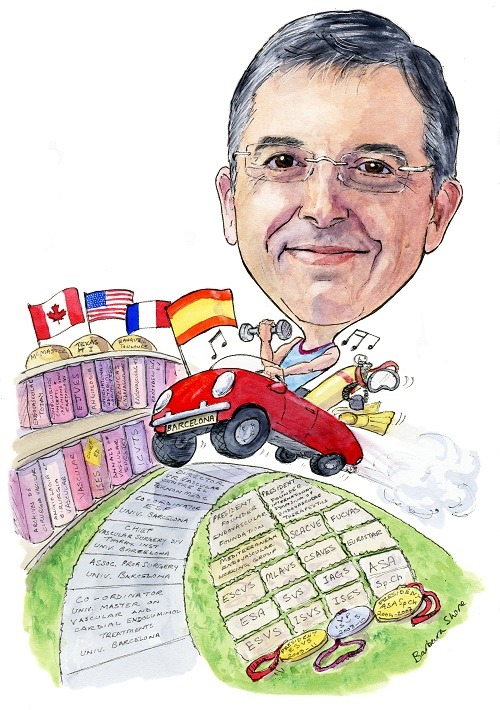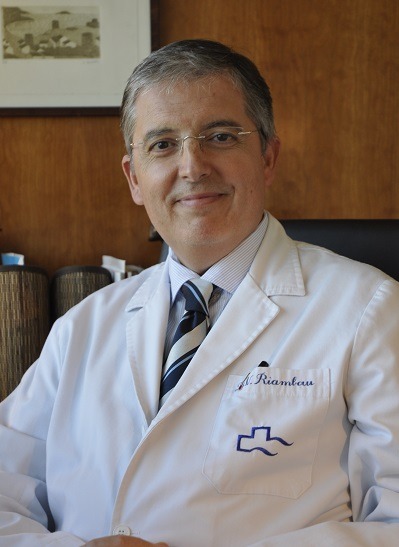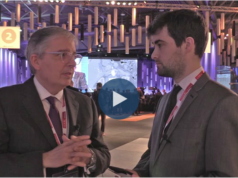
The first to do so in his family, Vincent Riambau always felt the pull to become a surgeon. Attending procedures whenever he could, he quickly found himself at home in the operating room at a young age. He spoke to Vascular News about how his passion for surgery, technological advancement and patient care has developed and adapted to the changing face of vascular medicine over the course of his extensive career.
Why did you decide you wanted a career in medicine, and why in particular did you choose to enter the vascular field?
I am the first and only physician in my family. That means that I did not have any familial reference or tutorial influence for this particular profession. However, since my early infancy I felt an inclination to become a surgeon; to serve the society through the patients with my hands and mind. I believe that it was a real vocation. At the age of 14, I met a general and orthopaedic surgeon, a friend of my father. Dr Casado was his name. One summer, I asked to attend one of his operations, in order to test my feelings towards the profession. He accepted and during that summer period a fascinating world was opened for the rest of my life. Every Wednesday during high school I attended and observed the elective operations he performed. When I started medical school, Dr. Casado’s first assistant left for another country and I became part of the surgical team. At that time, it was common to mix gastrointestinal surgical procedures with hip replacements and varicose veins surgery in one surgical session. When Dr Casado retired, he introduced me to another young and very skilled general surgeon, Dr Marti-Sintes. I continued my learning experience with him up to the end of my medical school education. I performed my first appendectomy, assisted by Dr Marti-Sintes, when I was medical student, at the age of 21 years.
Although general surgery was my favourite, it was too general and I felt the need to go deeper into a particular surgical field. Dr Marti-Sintes told me about vascular surgery—a new specialisation with a lot of professional opportunities. In the 1980s, vascular surgery was at the beginning of its history as an independent speciality in Spain. After the corresponding national exams, I secured one of the five national available positions for vascular surgery training. I was medical resident in the Hospital de Sant Pau de Barcelona for five years and obtained my certification for angiology and vascular surgery in 1990. Since then, vascular surgery has become one of my life motivations, focused on the wellness of vascular patients.
Who have been your most important career mentors and what wisdom did they impart?
Obviously, Drs Casado and Marti-Sintes were my first mentors, as previously explained. During medical school, Prof Carreras taught me about work and time management. Dr Capdevila—one of the fathers of the modern vascular surgery in Spain—gave me the opportunity to rotate twice in his large department. During my vascular training, Drs Sala-Planell and Viver-Manresa, my bosses, demonstrated to me the best way to perform elegant and effective open vascular surgery. Dr Rosendo encouraged me to explore new less invasive vascular treatments in the form of endovascular surgery. He also pushed me to visit some centres in USA, which I duly did. Dr Jimenez-Cossio shared with me his futuristic ideas about vascular surgery evolution and stimulated me to move forward my career with learning experiences at the best international centres.
After my training period, I had the opportunity to meet exceptional professionals and personalities who would influence my career, including M Buchanan from McMaster University and C Castellarnau from Autonomus University of Barcelona, director of my PhD programme. Frank Veith, Sir Peter Bell and Juan Parodi transferred to me their enthusiasm and support in my early experiences participating in international conferences. Dr Gimenez-Camarasa, my father-in-law, and my wife Dr A Gimenez-Arnau who taught me willingness, perseverance, tenacity, and tolerated my absences. I am sure there are many others to come, because every day is a good opportunity to learn.
What has been the biggest development(s) in vascular medicine during the course of your career?
Without any doubt, the endovascular approach for the aortic pathology is the most relevant issue in the last 50 years in the history of vascular surgery. I belong to a generation that was trained in high-performance open repair and we have incorporated revolutionary endovascular repairs and actively participate in their development. Right now it is very difficult to imagine my career without endovascular influence. The incorporation of endovascular tools in the vascular surgery armamentarium provided us a continuous source of innovation, discussion and scientific productivity in the vascular field.
What is the most interesting paper or presentation that you have seen recently (aside from your own research)?
I use to participate in many meetings over the year and read a lot of papers as a peer reviewer and by following the most relevant vascular journals. Honestly, nowadays it is rare to be surprised by new concepts or ideas around vascular or endovascular surgery. However, there are relevant contributions every day, confirming concepts with evidence and others creating more controversy. One especially interesting paper, though not that recent, has significantly influenced our practice. This paper was an Editor’s choice from the European Journal of Vascular and Endovascular Surgery published in 2014 by PM Kasprzak et al. It was related to the prevention of spinal cord ischaemia during endovascular repair of thoracoabdominal aneurysms by temporary aneurysm perfusion. Since this paper was published, we have adopted such prophylactic manoeuvres in our institution with excellent outcomes. Another, again not too recent, was in San Francisco during the open ceremony of the annual SVS meeting in 2013, in which Stéphan Haulon gave a memorial lecture about Roy Greenberg. It was a piece for reflection. I realised that we, as human subjects, are transient. Only our daily work, wherever we are living, will be our legacy that will make us immortal. Roy, despite his short life, gave us a tremendous example of immortality. Personally, I found it an emotive and stimulating talk.
You have been involved in the investigation of low-profile EVAR devices—how does the design of such devices impact their mid- to long-term durability?
Reducing delivery system profiles is a relative need. Certainly, low-profile devices could be beneficial to deal with more challenging anatomies, especially in TEVAR. However, it is not a good idea to sacrifice any features that contribute to durability. Durability still is the major concern for EVAR/TEVAR after 25 years of evolution. It is, in my view, the major challenge that allows me to qualify endovascular repair of the aorta as an immature technique. We have learned a lot about EVAR/TEVAR in the past two decades and have improved our devices with every new generation. However, we should be careful when we try to implement new modifications, even concepts that can create doubts about the real benefit of the all-endovascular approach. If we do not reduce intervention rates, it could be encouraging for the remaining non-believers, and more dangerously, it would be very disappointing for believers. We should build up the strength of endovascular repair rather than make take backwards steps that could debilitate all we have achieved.
You advocate a stronger integration between Spanish- and Portuguese-speaking vascular specialists—how can collaboration between these physicians and their English-speaking colleagues be improved?
Geographic and language links explain my special relationship with Portugal and Latin America. It is my mission to teach and transfer my experience and knowledge to my peers. Spanish language makes this approach easier. Spanish language is quite powerful and it is in part one of the drawbacks when the Spanish-speaking physicians try to learn and speak English. It is quite similar situation for the English-speaking colleagues. But English is the scientific and business language for excellence. Another limitation is related to the differences in levels of technological development, scientific tradition and production. Then, any help focused on such limitations could improve the collaboration between Spanish- and Portuguese-speaking specialists and their English-speaking colleagues. It would probably need more dedicated time on one hand and comprehension on the other hand.
What are the main challenges facing physicians practising in Latin America, Spain and Portugal? How do you think these challenges can be best addressed?
The common challenge is the limited financial support of public health that became worse with the recent economic crisis. I am not only talking about limitations on technical resources; public salaries are too low and the physicians are forced to be multi-employed, investing many hours per day just for practice. It is also quite difficult for physicians to expand their working hours for scientific and learning activities. I am afraid that this situation can be also found in other western countries. At the end it is a serious political problem, and should be addressed in every single country, especially when the public health system is the main care system.

An interventional approach for the treatment of uncomplicated type B dissections is still controversial. What is your protocol when faced with this group of patients?
Yes, it is indeed still controversial. Our management of uncomplicated type B dissection starts with an aggressive medical treatment in the cardiovascular intensive care unit, mostly focused on blood pressure control with betablockers as a first choice or with other hypotensive drugs when necessary. Besides the cardiovascular and medical condition evaluation, we focus our attention on the first diagnostic angio CT looking for morphological predictive factors such as overall aortic diameter, false lumen diameter, size and location of the main proximal tear and partial false lumen thrombosis. The angio CT is repeated within one week, looking for any morphological changes. If this is uneventful, the patient is discharged and followed with a new aortic imaging test (angio CT or MRI) at one month, six months and then yearly. Any clinical event during the first admission or during the follow-up such as uncontrolled pain, hypertension or malperfusion, deserves a proactive intervention of TEVAR with priority. Any morphological risk factor identified in the first admission or at one-month follow-up deserves an elective TEVAR after two weeks and before three months post-discharge. Hopefully, in the near future, this controversial issue can be overcome with more evidence, allowing us to standardise its management.
You are the chairman of the ESVS Guidelines on Descending Thoracic Aorta Management taskforce. Was it possible to reach a consensus on the controversies surrounding endovascular thoracic repair?
The ESVS Guidelines were written by 18 ESVS members and reviewed by a large multidisciplinary group of experts in the field. Since there are many gaps in evidence, most of the recommendations are based on levels B and C of evidence. In consequence, consensus was mandatory many times. In consequence, very few recommendations were class I. We hope to improve the strength of evidence for the next revisions. Nevertheless, for that purpose we would need more prospective randomised trials, but I am afraid that no one is on the track right now.
As President and Founder of the International Symposium on Endovascular Therapeutics (SITE) symposium, what highlights can we look forward to at the 2017 meeting?
SITE 2017 is coming back to the medical school. We have new and comfortable facilities that will provide a more academic atmosphere. During the symposium we will update the key points on venous and arterial endovascular techniques. As usual, with a very select guest faculty, we will offer a more practical perspective. We will combine main lectures on updated knowledge with complication sessions, tricks and tips sessions and challenging cases. We will also have a flavour of the SITEupdate, the small SITE version that is held every other year, in the middle of SITE meetings. SITEupdate is focused on unmet needs in endovascular therapy to be overcome in cooperation with the industry.
What are some of the proudest moments in your career?
I am proud and grateful for many moments in my career. The proudest element is the continuous recognition as the most international representative of the Spanish Vascular Surgery, being part of the most important vascular events all over the world and being invited as visiting professor at different universities such as Belgrade, Stanford and Pittsburgh. Second, becoming ESVS President Elect in 2009; it was a relevant step forward in my career. Third, I am proud of my team and my institution—Hospital Clinic of Barcelona—who enabled my professional development. Moreover, our fellowship programme has trained dozens of vascular specialists that also built brilliant careers in their countries, and initiative of which I am very proud. Having said that, I realise that my career is the consequence of a personal dedication and of the unrestricted support of my family. For that reason I am very proud of my relatives.
What three questions in vascular medicine still need to be answered?
There are of course more than three questions that remain to be answered! If I should choose just three, I would say the following, by priority: First, what is the best management for asymptomatic carotid stenosis? The second could be in the same direction but for uncomplicated type B dissections. And the third should be related to 4D or so-called functional imaging: will it be validated and included in the decision-making process for aortic pathology? I would also like to add another general one: is the endovascular approach durable enough? Hopefully, we and the next generations of vascular surgeons and researchers will give us relevant answers for the benefit of our patients.
What advice would you give to young vascular surgeons starting out in their careers?
I am trying to transfer to my young fellows the sense of the vascular surgery as a vocation in terms of dedication, continuous learning and demanding of oneself to offer their patients the best solution. Use the best ethical behaviour in all the personal relationships and try to comfort patients and relatives, especially when there is nothing else that can be done for them.
What are some of your hobbies and interests outside of medicine?
Honestly, I do not have much time for hobbies, though obviously I have some. I like to travel and discover new cultures and areas of nature. I prefer to use my car because I love to drive—in sports cars whenever possible. I also like sailing and diving, to be abstracted and concentrated in other activity which is quite different to my professional job. I enjoy going to the cinema; action or funny films are my preferred genres. I also enjoy visiting the opera house, especially for Italian operas. I enjoy spending some time in the gym two or three times per week for fitness purposes. Finally, it is very relaxing to me to spend time with my family or my friends around a good gastronomic experience. Those are very basic and incidental hobbies. I reserve the heaviest for the future.
Fact File
Education/Training
- 1979–85 Medical School, Hospital Clinic of Barcelona, University of Barcelona, Spain
- 1985–90 Angiology and vascular surgery training, Hospital Sant Pau, Barcelona, Autonomous University of Barcelona, Spain
- 1988 Visiting Fellowship, Texas Heart Institute, Houston, Texas, USA
- 1988 Clinical Fellowship, Rangueil, Toulouse, France
- 1990 Research Fellowship, McMaster University, Hamilton, Canada
- 1990–97 PhD, Autonomous University of Barcelona, Barcelona, Spain
Positions and employment
- 1990–present Vascular Surgeon, Autonomous University of Barcelona, Spain
- 1991–92 Consultant Vascular Surgeon, Hospital la Alianza and Hospital del Mar of Barcelona, Spain
- 1993–present Associated Professor of Surgery, Autonomous University of Barcelona, Spain
- 2001–present Director of VR Vascular Centre SL, at Teknon Medical Center of Barcelona, Spain
- 2003–present Coordinator of the Endovascular Surgery Programme, Institute of Cardiovascular Diseases, Hospital Clinic of Barcelona, University of Barcelona, Spain
- 2005–2007 Director of Institut Vascular Sala-Planell at Teknon Medical Center of Barcelona, Spain
- 2007–present Chief of Vascular Surgery Division of Thorax Institut, Hospital Clinic, University of Barcelona, Spain
- 2014–present Coordinator of the University Master on Vascular and Cardiac Endoluminal treatments, University of Barcelona, Spain
Selected other experience
- 1998–2006 Elected Member of the International Council of the International Society of Endovascular Specialists (ISES)
- 2000–present President and Founder of the International Symposium on Endovascular Therapeutics
- 2004-2007 President of the Spanish Chapter of the American Society of Angiology
- 2009–2011 President of European Society for Vascular Surgery (ESVS)
- 2015–present President and founder of Endovascular Foundation












